Provence and Occitanie: Day 4
- lendroitheureux
- May 3
- 13 min read
Updated: May 18
Aix-en-Provence: Art, Fountains, Rain Train Rain, and Whence I Ate Pigeon
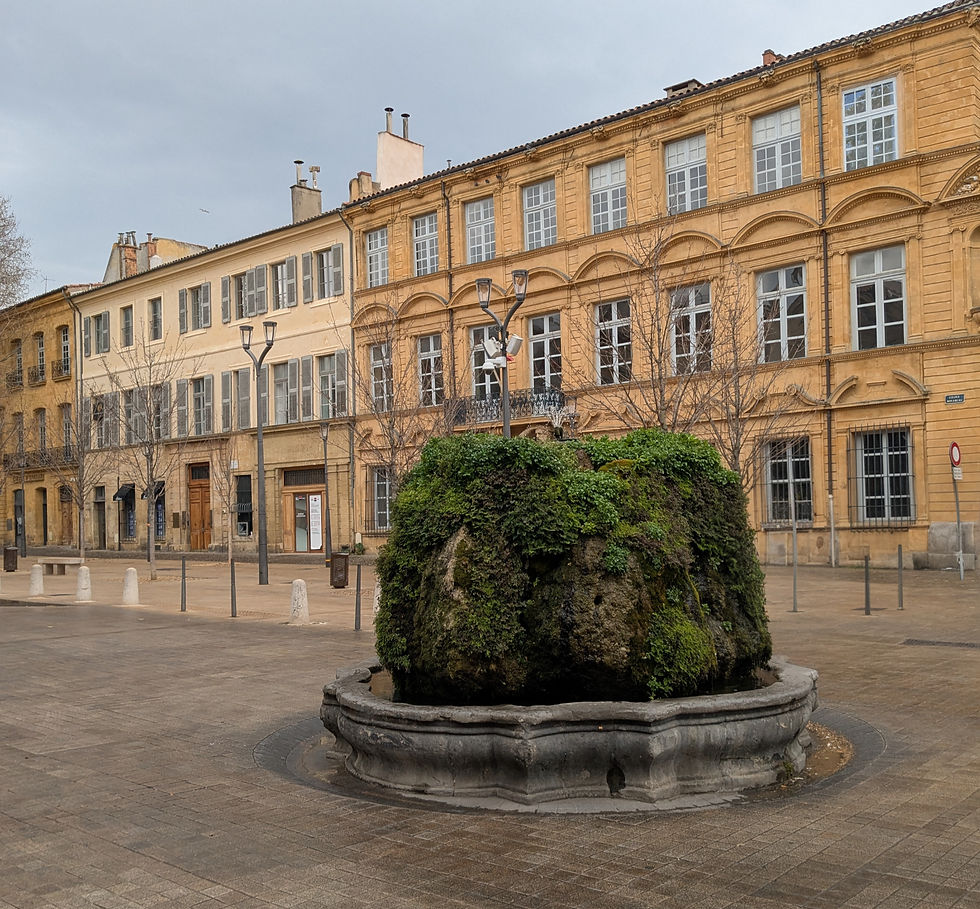
Waking up on Sunday, our fourth day in Southern France (and last in Marseille), we were greeted with cloudy, leaden skies and a strong wind. In a previous post, I mentioned the Mistral: gale-force winds, the stuff of which legends are made. While there were winds throughout our first three days, we had yet to experience the billowing of a Mistral. It appeared as if we may this day.
As with the previous days, I ventured out alone to hunt down some coffee and have my morning relaxation. The Vieux Port hosted a bustling farmer's market-plus, offering fresh produce and more: wine, cheese, fresh bread, honey, and even lavender lip balm (which I purchased). I saw an Ethiopian food vendor, and as Ethiopian is one of my favorite cuisines, I was tempted. It was before 10 a.m. I hadn't had coffee yet, let alone any sort of breakfast. Ethiopian at that time may have… ahem… changed the dynamic of how the morning and rest of the day would flush out. I headed to the cafe on the corner.
It was windy. Harsh, mean, blowing, constant. I witnessed a few of the vendors' items blow over or away, but for the most part, things stayed put. I was quite impressed with the way the merchants managed through the Mistral. They were drawing upon centuries of experience, so it's understandable, but still. Bravo!

Along with the Mistral, we knew there would also be rain. If not Sunday, sometime in the near future. The weather forecast predicted rain in some way shape or form for at least half of our remaining days. We decided I should try to track down an umbrella before we checked out of the hotel to make our way to St. Charles Station. As I sipped my espresso (“expresso” in France), I spied a newsstand on a corner near Place aux Huiles. I finished my coffee, stubbed out my cigarette, dodged Sunday morning traffic, and managed to keep my shirt from blowing off as I approached the stand. The vendor, an older gentleman wearing one of those squat European chapeaus and smoking a gnarled cigarette butt, was talking trash to another fellow in Provincial French. I saw one umbrella hanging up at his stand. Fortune favored me that day. I grabbed it and made the transaction in perfect French (ha!) while the fellow received me and the 10-euro payment graciously, all the while still bantering with his friend.
This kind of small everyday transaction makes me so happy and stands out in my memory travelogue. I bought an umbrella. Big deal. But it went smoothly; the conversation was in French without awkwardness. A win! I regaled Lani with the story in the way a child would tell his mom about climbing to the lowest branch on the smallest tree in the yard. I was proud of myself. Look at what I did! I'm a big boy!

We took the underground metro, the M1 line, from Vieux Port stop (there's a fish tank inside) to Gare Saint-Charles to catch a train for Aix-en-Provence and our second leg of the grand tour of Southern France. Aix is less than 30 miles from Marseille with trains leaving about once per hour, and we didn’t need to secure passage with a reserved seat. It’s really easy to get tickets at the train station. Use one of the many kiosks, choose your preferred language, your destination, mode of payment, and viola. It’s no more complicated than using an ATM. The same goes for most city public transit (bus, trams, metro, etc.). Usually these systems are very user-friendly, so using transit in all of its forms shouldn't induce anxiety.
One thing to pay close attention to when traveling via train in France is the station that you want to utilize in each location. Larger cities (like Paris) will often have multiple stations within the city. Even smaller locales will have multiple stations: those closer to the town center and those outside of the city. The TGV, or “Train a Grande Vitesse,” is the high-speed train that can travel nearly 200 mph. The stations for the high speed trains are often some distance outside of town. The TER, or “Transport Express Regional,” is the intercity train that runs more often and is used for shorter jaunts and commutes. TER stations are situated closer to the old city centers that, as a tourist, you will probably want to see. The TER trains also stop at TGV stations, so just be certain you buy a ticket for the correct station, and also get off at the station you want. It’s really quite simple, just read, pay attention to what you are doing, and take note of the stations when the train pulls in. We were headed to Aix center, so we traveled via TER this time.

As we were leaving Marseille, the wind picked up and the rain rolled in. The large train station wind-tunneled the mist toward the platforms and interior of the station. We boarded, sat relaxed, and soon were watching the urban and suburban landscape roll by, awash in a provincial soaking.

Upon arriving in Aix-en-Provence and stepping off the train onto the wet, slippery platform, we immediately realized that the Mistral had indeed arrived. It was wicked. We had to follow along with the other passengers, walking in a line toward some stairs, up and then across a gangplank over the tracks, down some other stairs to the station. The Mistral really made its presence known up on that walkway. Luckily, our hotel was mere minutes away. We trudged along, our Marseille-procured umbrella precariously hovering over the two of us as we clickety-clackety pulled our suitcases along the abandoned sidewalks. A windy, rainy Sunday morning and no one was out and about. It was eerie. It was kinda cool. We had the streets of Aix-en-Provence to ourselves. At least for the 9 or 10-minute walk to Hotel des Augustins.

Hotel des Augustins is located in an old (12th Century) Augustinian convent. The vaulted ceiling in the lobby is enough to make you gasp (as I did) as you step inside the warm, old stone confines of an ancient building from the lashing rain (as we did). We arrived early; it was barely noon, so we checked our bags and went on our way to one of the jewels among many in Aix-en-Provence: Le Musee Granet. I planned our sojourn to Aix on Sunday because Granet is closed Mondays, and we both really wanted to see what the museum offered.
Granet was a short 10-minute walk, and the rain had slowed to a steady drizzle, not the torrent we experienced when stepping from the train. I knew there would be some fountains on the walk to the museum, and thus we could “knock some things off the itinerary”on the way there. That’s how I talk about the trip and itinerary: it’s so dense that often it’s as if we are on a strict, military-like regimen with no room for error and no dilly dallying allowed. Thus, if we can “knock something off the itinerary” as we are heading to another itinerary item, sobeit. On y vas! Allez! Allez! Vite, vite!

Let me digress a tad. Aix-en-Provence was founded by some Roman dude named Gaius Sextius, who also is in the running for “Best Historical Name Ever” award. Monsieur Sextius was the person who gave “Aix” (meaning water) its name. The area boasted many natural springs, and currently Aix-en-Provence has a plethora of fountains. Many fountains. Fountains galore! I have tried to find a list of all the fountains. I poked into forums, bothered chat groups, and went on the main to see if there was an extant record of each one. No dice. I had to make a list on my own, and list I did! The itinerary for Aix was LONG! It looked daunting. In reality, it was a walking tour of the old city center with a lot of fountains to see. On the way to Musee Granet, there were two. Two of the more iconic fountains, and I was hyped! My excitement was flowing. Like a fountain. So off we flew.
Hotel des Augustins is one-half medieval block from the main promenade, Cours Mirabeau. There is a lot to say about Cours Mirabeau, and I will do so in the next post. From small Rue de la Masse, we stepped onto Mirabeau, looked to the right, and saw the grand, round, marvelous “Fontaine de la Rotonde.” It sat two blocks away but seemed closer due to its size. It was in the wrong direction for our current journey and would thus have to wait until later. It would still be there, I was certain.
A fountain that happened to be on our walking path was the splendid, squat, mossy, and mean “Fontaine Mousse” (also referred to as “La Fontaine Deau Chaude”). It’s a round, rock-like fountain about 7 or 8 feet tall, resting on a plinth in a basin not much wider than the large green boulder. I say “mean” very tongue-in-cheek, as while I was making a video, circling the friendly fountain, a gust of Mistral caused the rock to spit at me and cover me with stone saliva. I got it on video. The rock purposely spat in my general direction! I loved it.

Three blocks directly south from Fontaine Mousse, in a fine little round-a-bout plaza, sits the Fontaine des Quatre Dauphins. Created in 1667, this fountain has the eponymous four dolphins carved around the base of an obelisk. It's one of the more iconic fountains in Aix and yet unassuming, not garish or “loud.” It's lovely. That we got to see these two fountains immediately upon setting out started our fine art themed day off on the right foot.

Musee Granet is also unassuming and small. It's not tiny, and it definitely has its so-called “masterpieces” and fine works, but it's just the right size for a three or four-hour visit. There was a line to get in, as the museum had just opened its doors for the day, so we decided to walk a bit, track down a boulangerie, and get a quick snack which we secured in my bag to stow in one of the lockers at Musee Granet.

Musee Granet is a must-see. I initially chose Aix-en-Provence as one of our cities to stay in based largely on Granet’s existence. Apart from Cezannes (three examples above), Granet has a gallery room dedicated to Giacometti (one of Lani’s favorites). These alone would suffice a visit, but there's so much more. Matisse, Picasso, Rembrandt, Rubens, and many, many others. There are a lot of works specific to Aix and to Provence in general, including some extremely interesting ancient archeological artifacts from the local area. These remnants of the Gaulic peoples called Salyans, dating back to 425-25 BCE, include pottery, sculptures, religious symbols, and household and agricultural tools. These are indeed treasures.
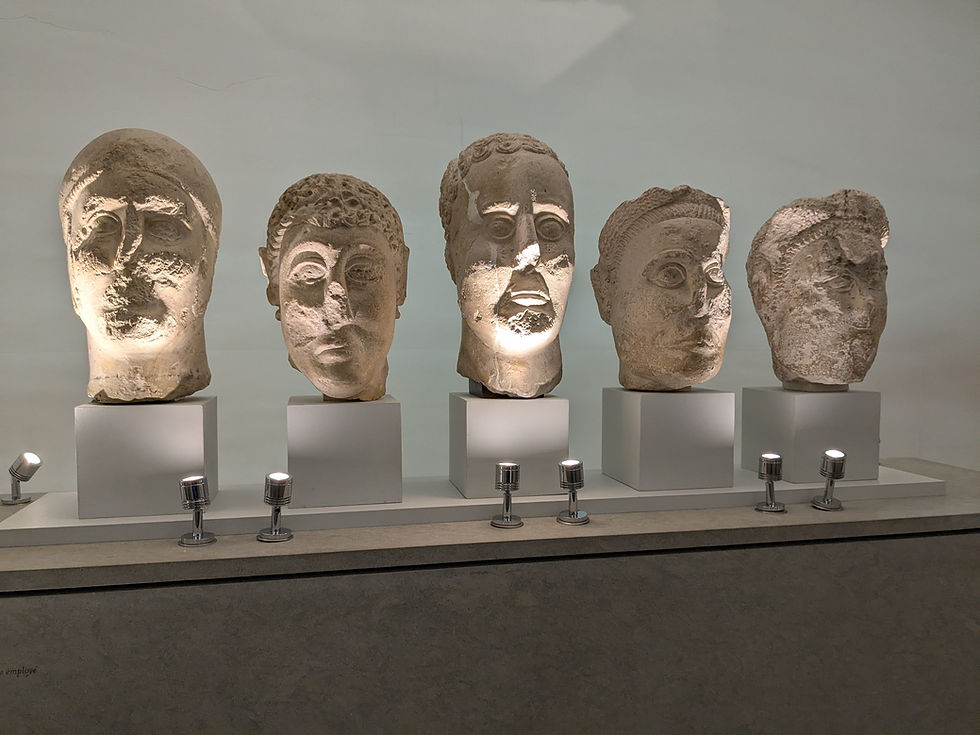
I always appreciate Dutch and low-country pictures from the 16th, 17th, and 18th centuries, especially when they depict everyday life of the local peasant or urban poor. These images are often raucous and simply a delight. Of course, I can’t get enough of Salome with the head of John the Baptist and the ubiquitous Saint Sebastion getting pin-cushioned by arrows.


One fine work that I want to highlight, and which has given me everlasting joy since I gazed upon its lascivious goodness, is a tableau by an anonymous artist titled La Femme Entres les Deux Ages. This is a reproduction of what appears to be a very common scene from the era. There are similar images, with the same title in, for example, the Louvre (an engraving) and Le Musée des Beaux-Art de Rennes, among others. The painting depicts a young, attractive woman in fine, yet sheer, attire in the center of the picture. She is being held with both hands by an equally as young and attractive man, also finely attired, standing to the left. The woman has her pointer finger and thumb together at the tips to form a circle. The finger circle is around the young man’s pinky finger, thus making the internationally recognized “fucky, fucky” symbol. To the right of the woman is an old man, head slightly angled downwards and wearing an entirely black garment (including a hat) reminiscent of a monk’s mantle. The woman is handing the older man a pair of spectacles. The mantle and posture of the old feller symbolize his impotence, and the glasses might be alluding to the fact that he is a money-hoarding stingy jerk. So it’s all very clear: This young vixen is going to get with the young rich guy, not the old rich guy. Shocking. This popular scene is most likely from the Comedia Dell’Arte, an Italian form of stage comedy popularized in France, thanks in a large part to good ole Catherine de Medici (see Provence and Occitanie: Day 3, Part 1). I like it. It’s fun to look at.
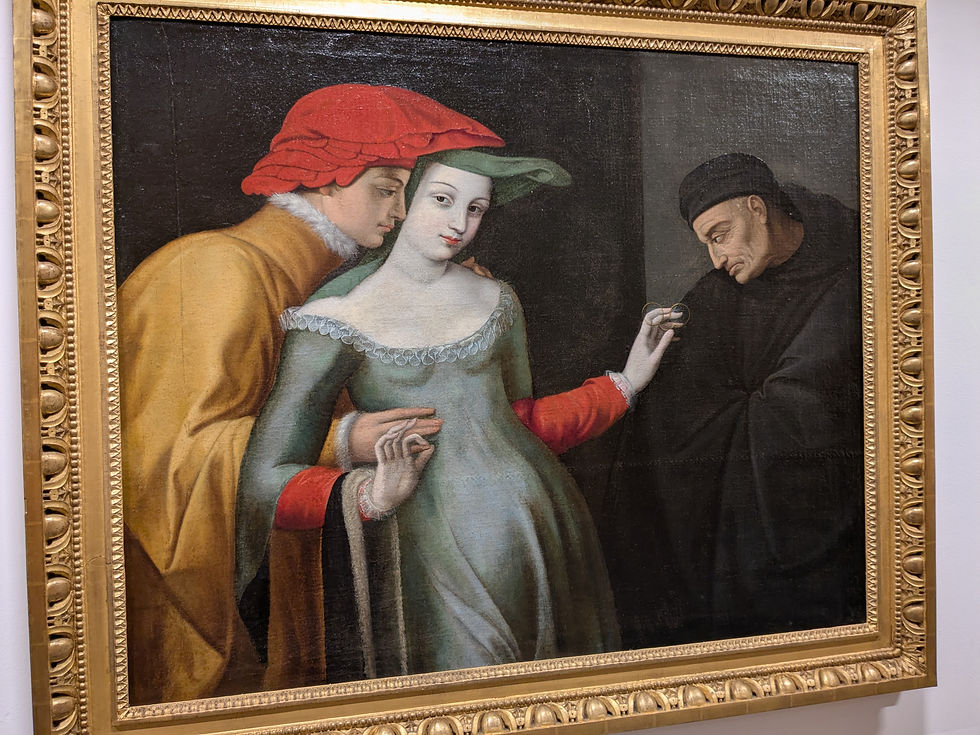
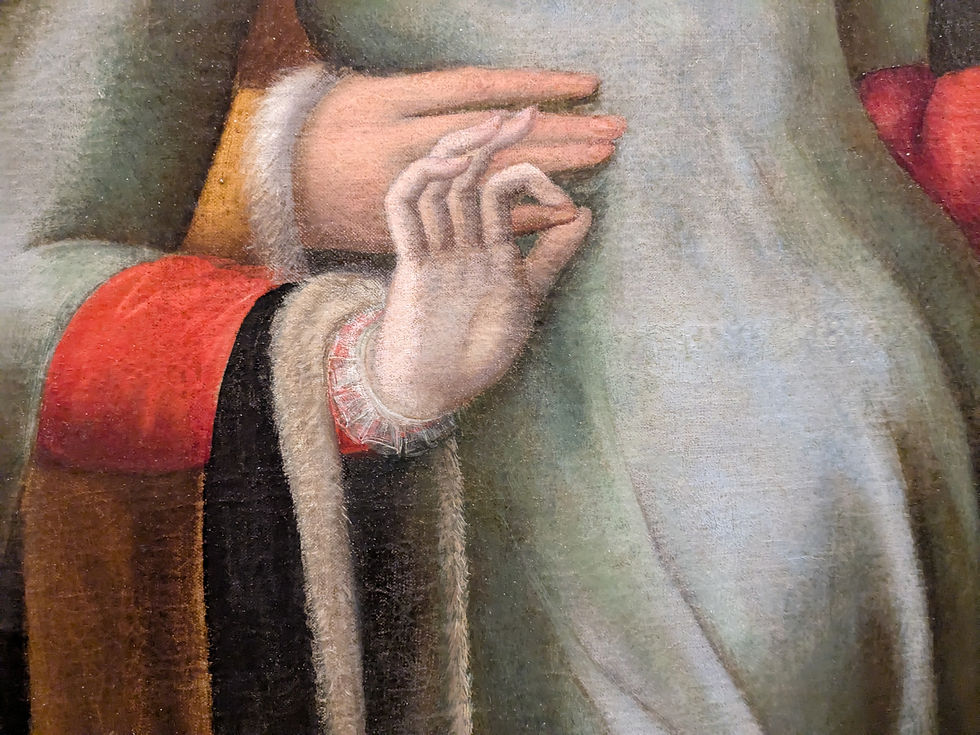
Sure, one can sit and enjoy the glow and glory of the master’s masterpieces (and one should), but for me, pictures (and sculptures) such as La Femme Entres les Deux Ages and the scores of other lesser known pieces are the real joy of visiting fine arts museums. Rummage around, search, and you will be bound to find at least a couple artworks that speak to your vibes, your vices, your religious inclination, and your aesthetic tastes that you may not have come across before. It’s such a joy!
Right outside the door to Musee Granet and sharing the plaza with a small fountain is Eglise Saint-Jean-de-Malte, a church that dates back to 1270. Yeah. 1270. I don’t know what awes me more: the beautiful and extremely high vaulted ceilings, the ancient seashell-shaped holy water basins, or the scores of religious art and artifacts dotted throughout. But it was all there, awing me.


I really like taking note of the various tabernacles around churches. Often they are numerous with each side chapel having its own tabernacle. The curtain or door that secrets away the eucharist adds to the mystery (quite deliberately) and mystical aura of the whole experience. I was raised Catholic (quite lapsed now). Thus, these old churches are quite familiar and also help me understand aspects of my younger days’ experiences that I did not grasp back then. Saint-Jean-de-Malte was splendid in that it offered all the hits: a nice pipe organ, original paintings with overly-dramatic (and often quite violent) images of Christ and the saints (Saint Sebastian returns), the aforementioned chapels and tabernacles, and parts of the walls and ceilings showing original and quite old masonry, frescos, and paint. A perfect way to either end or begin your visit to Musee Granet. Oh, did I mention there’s a tiny fountain in the plaza outside? I love fountains.

After Saint-Jean-de-Malte, we walked down the narrow rues of Aix in a nice, calming drizzle to return to Hotel des Augustins and check in. Since we had dinner reservations for that night, we figured a few hours rest in a centuries-old nunnery-now-hotel while the French sky dribbled drizzle on the cobblestone street outside would be quite relaxing. It was.

La Bouchee is a cute, cozy restaurant just a four-minute walk from Hotel des Augustins. There are numerous pleasures I experience when in France while exploring the cities, villages, and countryside (if that wasn’t already obvious). One of the greatest simple pleasures for me is walking small, winding, maze-like cobblestone streets in old city centers. I adore it. If it’s raining? I am in heaven. No hyperbole. Our first day in Aix-en-Provence ascended me to heaven at least five or six times, and I am not sure whether or not I ever landed back on earth. Well, I know I did, because La Bouchee is back on earth and yet its environment and cuisine is as close to heaven as one can get while dining in France.
La Bouchee is small, with an upstairs dining area next to an open kitchen and a downstairs dining room. When we arrived, the server asked us which room we preferred. I immediately blurted out “DOWNSTAIRS” for no particular reason at the time. And boy howdy am I pleased I did. The basement is a small, vaulted ceiling, stone-walled cave. We spent time in a vaulted church, walked cobbled streets, and were staying in a hotel with vaulted ceilings. Of course, our first dining space in Aix would be of medieval ilk with vaults and stones. But that's just the beginning. What about the food? La Bouchee was special. It IS special. I did a fair amount of research leading up to the trip on restaurant options, and La Bouchee really stood out for me in Aix. The concierge at Hotel des Augustins seemed impressed we had reservations (a comforting affirmation of our choice), and we were excited. I even knew what I would order, having perused the online menu far too many times: pigeon.
Our dining experience was, as expected from a fine French establishment, outstanding. We started with “Oeuf Parfait,” a poached egg with artichokes, mushrooms, and bread. I crave poached eggs in France, whether in a salad, “les oeufs avec mayonnaise” or in any form. As this form. The savory umami of the egg/artichoke/mushroom came together wonderfully to begin the meal. Then arrived my pigeon and Lani’s "Poisson du Moment" (catch of the day) whitefish with brussels sprouts, potato, and watercress which looked (and I am told was) simply divine. I like to try new things in France, and dive into dishes that I probably would not have access to in the states. I also figured if any place would serve up a perfectly delightful pigeon, it would be La Bouchee. I was correct.

Swimming in a brown liquid of what I can only assume to be pigeon sauce, were peas, carrots, purple cauliflower, and potatoes with the pigeon perched atop, next to a well-proportioned portion of foie gras. It was delectable. It melted in my mouth, fell off the bone, and all the other cliches people use to describe excellent bone-in protein. I would have ascended yet again to heaven had it not been for the century’s old stone basement cave keeping me terrestrial. We opted for the cheese plate for dessert which came with a generous pour of herb-infused olive oil, a dollop of marmalade, fresh bread, and the best cheese we had ever had in our lives. Up to that point. Until the next cheese. A truly top-notch gastronomical experience, all around.

We slow-walked home through a very light Sunday night drizzle. There were a number of restaurants just gearing up for the Ramadan Iftar, and more people walking about than I would have expected for a Sunday night. Yet, it was peaceful. The rain, stone streets, churches, and the glow from the cafes and restaurants all helped Aix-en-Provence introduce itself to us in a most genial and artistic manner indeed.






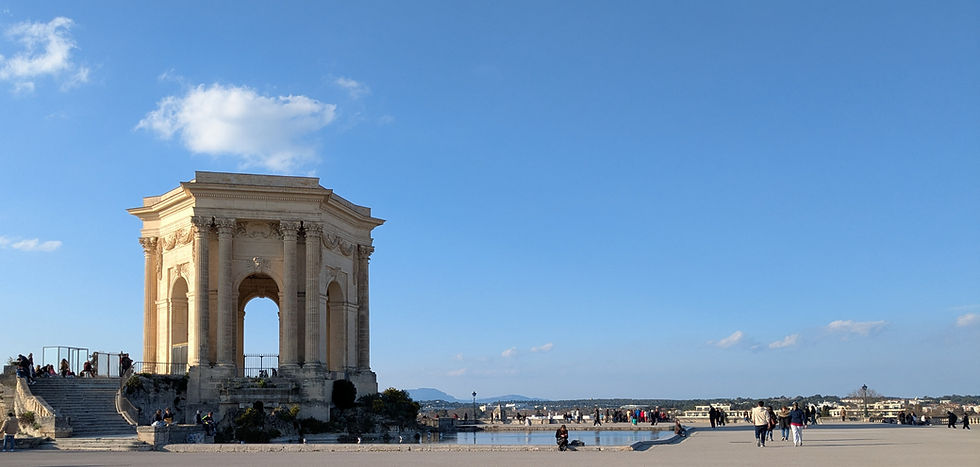


Comments